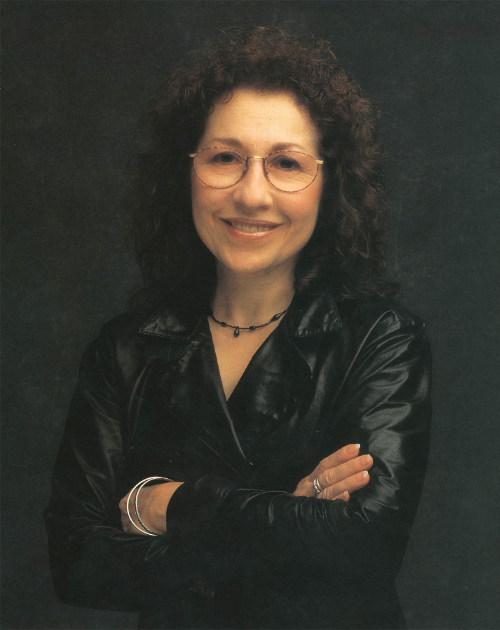
“[In 1960] I underwent an internal revolution. I no longer felt that I had to please . . . but knew that I could express myself. I did that through human figures...”[i]
NANCY GROSSMAN (b.1940)
A master of sculpture, drawing and collage, Nancy Grossman was born in New York City to parents who worked in the garment industry. She began drawing figures at six, made a marionette for her siblings, and would use the sewing machines after hours to make doll clothing. These experiences had a strong effect on her art, which often features textiles and leather. She graduated from the Pratt Institute in 1962 and also won an Ida C. Haskell Award for Foreign Travel, which enabled her to spend time in Europe. In 1965, she received a fellowship from the John Simon Guggenheim Foundation.
(c)Timothy Greenfield-Sanders, Courtesy of the Photographer.
In the 1960s, Grossman began creating her famous sculptures of heads, which she carefully carved from the wood of discarded telephone poles, overlaid with leather, and then adorned with zippers, glass eyes, enamel noses, spikes, and straps. While their size, shape, and facial features suggest masculinity, she refers to them as self-portraits, implying the mutability of gender and demonstrating that all artwork offers something of the artist. These works contain the central aspects of Grossman’s art: an embrace of gender ambiguity, an interest in formal contradiction and conflict, an audacious use of leather, and a rich sensuality. Grossman’s sculptures appeal as much to the olfactory and tactile senses as to the visual; they taunt viewers with their invitation to touch.
Her work has been shown in major museum exhibitions, including a solo exhibition at PS1-MoMA and a five-decade survey at the Tang Museum at Skidmore College. Awards include a National Endowment for the Arts Fellowship (1984), a New York Foundation for the Arts Fellowship (1991), a Joan Mitchell Foundation Grant (1996-97), and a Pollock-Krasner Foundation Grant (2001), and her work is represented in the permanentcollections of museums worldwide.
[i] Nancy Grossman, quoted in Arlene Raven, Nancy Grossman (Brookville, New York: Hillwood Art Musem, CW Post Campus of Long Island University, 1991), 82.
Jay DeFeo (1929-1989)
Jay DeFeo was a long-time resident of the San Francisco Bay Area. She studied art at the University of California, Berkeley, receiving her masters of fine arts degree in 1951. Upon graduation, the university awarded her a fellowship, which she used to travel through Europe and North Africa in 1951 and 1952.
Returning to the Bay Area in 1953, DeFeo became a pivotal figure in the historic San Francisco community of artists, poets and jazz musicians of the 1950s. The art she made incorporated the dualities of representation and abstraction, organic and geometric form, refinement and expressionism, opposition and relation. DeFeo worked with unorthodox materials to explore the broadest definitions of sculpture, drawing, collage and painting.
In 1959 DeFeo’s art was included in Dorothy Miller’s momentous exhibition Sixteen Americans at the Museum of Modern Art in New York. Walter Hopps and Irving Blum at the Ferus Gallery in Los Angeles mounted her next solo exhibition in 1960.
In 1958 DeFeo began work on “an idea that had a center to it” and almost eight years later, in 1966, completed The Rose, a monumental work created with so much oil paint that she called it “a marriage between painting and sculpture.” The Rose was first exhibited in 1969 at the Pasadena Art Museum.
In the 1970s, DeFeo began investigating new materials and became deeply involved with photography. Often her subjects were favored domestic oddities, which she transformed into images that, in her words, “transcend the definition of the objects from which they are derived.” A master draftsman and painter, DeFeo was also an ardent experimenter, allowing her to create an idiosyncratic cross-disciplinary oeuvre.
In 1981 DeFeo moved to Oakland and built her largest and most light-filled studio. Continuing to mix and assemble materials in her works, she created large, glowing canvases and small, delicate paintings.
Portrait of Jay DeFeo, 1976. (Photo by Mimi Jacobs)
In 2012, the Whitney Museum of American Art presented Jay DeFeo: A Retrospective. DeFeo's works are in the permanent collections of The Museum of Modern Art, New York, The Art Institute of Chicago, British Museum, Centre Pompidou, Whitney Museum of American Art, San Francisco Museum of Modern Art, Fine Arts Museums of San Francisco, Los Angeles County Museum of Art, J. Paul Getty Museum, The Menil Collection and many others.
Detailed information about Jay DeFeo’s life and work can be found at: www.jaydefeo.org


